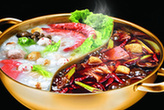|
|
Frustrated, in 1693 Shi Tao converted to Daoism and returned to Yangzhou in his fifties. There, he gradually found in his own heart a land of peace away from the turmoil of the world.
In 1699, Shi made a public admission of his identity as a scion of the Emperor of the Ming Dynasty and began signing his paintings with his real name—Ruoji.
Shi was torn between ambition and a desire to retreat into solitude throughout his entire life, stirring internal contradictions and tensions within him. Fortunately, being a smart man, he took advantage of this tension in his paintings, creating his unique artistic style.
 |
Painting of Jin Shan Long You Temple |
His paintings exemplify those contradictions and have been interpreted as “an invective against art-historical canonization”.
Characteristics of Shi Tao’s Works
Many of Shi’s paintings were based on his own observations in real life.
During his first visit to Huangshan Mountain in Anhui province at the age of 28, the landscape there left a deep impression on him. Later, he lived alone on the mountain like other painters, searching for originality from the beautiful landscape. He became an important member of the Huangshan School of Painting which holds an important position in China's painting circles.





Why not rent a boyfriend, or girlfriend to please parents during the Spring Festival?